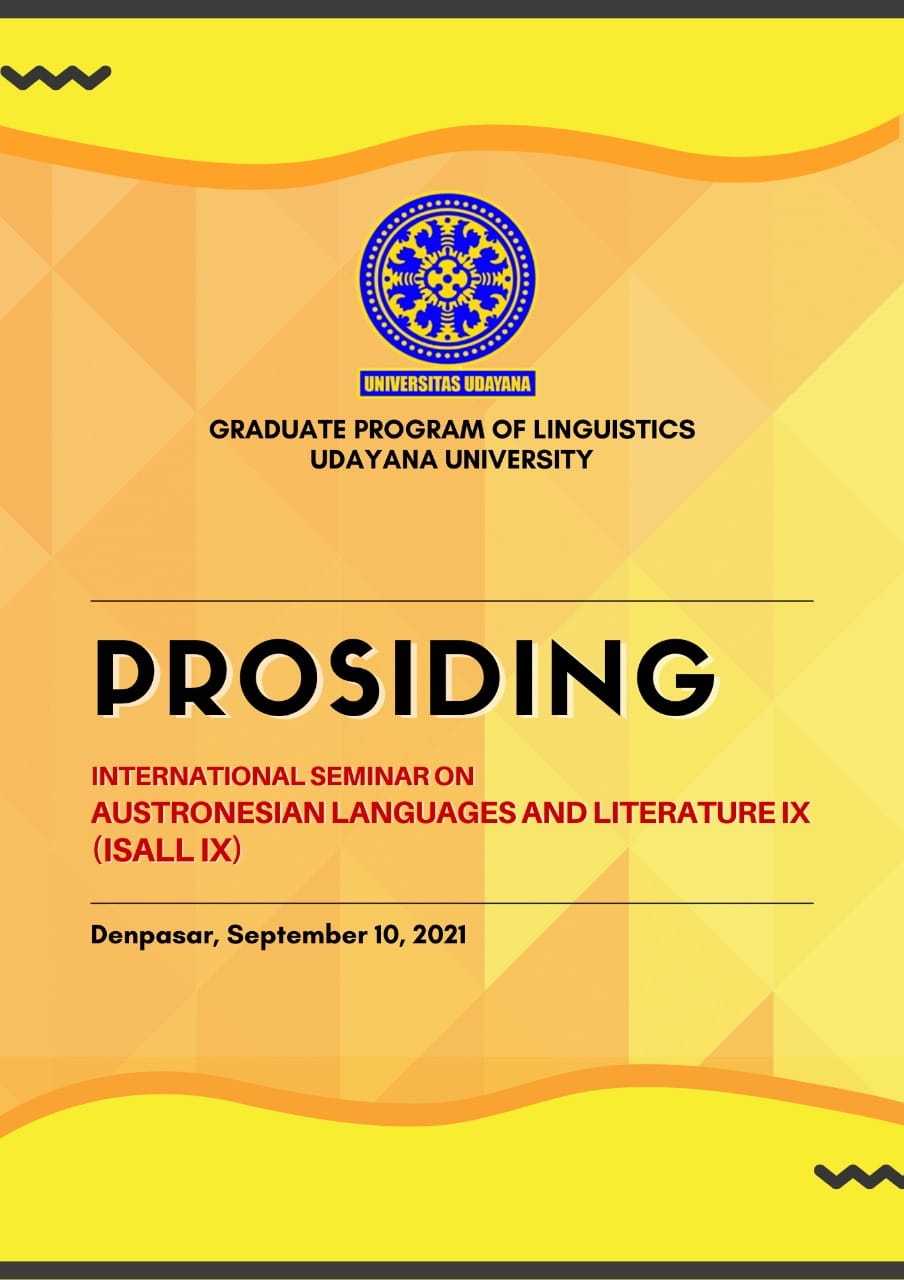The Construction of Adverb of Time in Bima Language: Syntax Perspective
Abstract
The current study attempts to describe the pattern of the syntactic construction of adverb of time in Bima language. The research data are in the form of a simple sentence used by Bima ethnic. The data collection was carried out using the observation method. Based on the data analysis, the results showed that (1) there were four adverbs of times used by Bima ethnic, namely; continuous, present, future, and past tense, and (2) the simple sentence pattern of adverb of time of Bima language consist of Subject (S) + Predicate (P) + Noun Phrase (NP) + Preposition Phrase (PP)
References
Banguis, R., & Bantawig. (2020). Generating Patterns of Syntactic Style and Syntax Structure on Siquijodnon-Cebuano Folksong. Journal of Critical Reviews, 7(11), 194-202.
Chomsky, Noam. (2002). Syntactic Structures. Berlin and New York: Mouton de Gruyter.
Fauzi, M. I., Nirmala, D., & Subiyanto, A. (2020). Adverb of Time in Arabic Simple Sentence. Language Literacy: Journal of Linguistics, Literature and Language Teaching, 4(2), 263-270.
Miles, M. B., Huberman, A. M., & Saldana, J. (2014). Qualitative Data Analysis: A Methods Source book (3rd ed.). Thousand Oaks, California: Sage Publications, Inc.
Junaid. (2018). A Syntactic Analysis of the English Noun Phrase (A Study at the Fifth Semester of English Department Faculty of Teacher Training and Education University of Muhammadiyah Makassar). PERSPEKTIF: Jurnal Pengembangan Sumber Daya Insani, 3(1), 317-326.
Novita, S., & Widayati, D. (2018). Kekerabatan Kosa Kata Bahasa Karo, Bahasa Nias, dan Bahasa Simalungun di Kota Medan: Kajian Linguistik Historis Komparatif. Linguistika, 26(2), 109-125.
Susandhika, et. al. (2016). Fungsi, Kategori, dan Peran Sintaksis Dalam Talk Show One
“Indonesia Lawyers Club” di TV One. LINGUISTIKA, 23(44), 20-36.
Taembo, M., Dhanawaty, N. M., Mbete, A. M., & Putra, A. A. (2018). A Geography Dialect of Wakatobi Language in South east Sulawesi. e-Journal of Linguistics, 12(2), 88-98. doi:10.24843/eJL.2018.v12.i02.p.02.
Umar. (2020) The Meaning Difference of Lexicon “Sakit” in Bimanese: A Semantics Perspective, e-Journal of Linguistics, 14(1), 71-76. doi.org/10.24843/e-jl.2020.v14.i01.p08.
Zahro, S. K. (2018). English Syntax Acquisition Order of Indonesian Elementary School Learners: An Analysis of Grammatical Function of Third and Sixth Grade. Edulitics Journal, 3(2), 37-43.
Chomsky, Noam. (2002). Syntactic Structures. Berlin and New York: Mouton de Gruyter.
Fauzi, M. I., Nirmala, D., & Subiyanto, A. (2020). Adverb of Time in Arabic Simple Sentence. Language Literacy: Journal of Linguistics, Literature and Language Teaching, 4(2), 263-270.
Miles, M. B., Huberman, A. M., & Saldana, J. (2014). Qualitative Data Analysis: A Methods Source book (3rd ed.). Thousand Oaks, California: Sage Publications, Inc.
Junaid. (2018). A Syntactic Analysis of the English Noun Phrase (A Study at the Fifth Semester of English Department Faculty of Teacher Training and Education University of Muhammadiyah Makassar). PERSPEKTIF: Jurnal Pengembangan Sumber Daya Insani, 3(1), 317-326.
Novita, S., & Widayati, D. (2018). Kekerabatan Kosa Kata Bahasa Karo, Bahasa Nias, dan Bahasa Simalungun di Kota Medan: Kajian Linguistik Historis Komparatif. Linguistika, 26(2), 109-125.
Susandhika, et. al. (2016). Fungsi, Kategori, dan Peran Sintaksis Dalam Talk Show One
“Indonesia Lawyers Club” di TV One. LINGUISTIKA, 23(44), 20-36.
Taembo, M., Dhanawaty, N. M., Mbete, A. M., & Putra, A. A. (2018). A Geography Dialect of Wakatobi Language in South east Sulawesi. e-Journal of Linguistics, 12(2), 88-98. doi:10.24843/eJL.2018.v12.i02.p.02.
Umar. (2020) The Meaning Difference of Lexicon “Sakit” in Bimanese: A Semantics Perspective, e-Journal of Linguistics, 14(1), 71-76. doi.org/10.24843/e-jl.2020.v14.i01.p08.
Zahro, S. K. (2018). English Syntax Acquisition Order of Indonesian Elementary School Learners: An Analysis of Grammatical Function of Third and Sixth Grade. Edulitics Journal, 3(2), 37-43.
Published
2021-11-20
How to Cite
UMAR, Umar.
The Construction of Adverb of Time in Bima Language: Syntax Perspective.
International Seminar on Austronesian Languages and Literature, [S.l.], v. 9, n. 1, p. 287-292, nov. 2021.
Available at: <https://ojs.unud.ac.id/index.php/isall/article/view/79931>. Date accessed: 25 dec. 2025.


